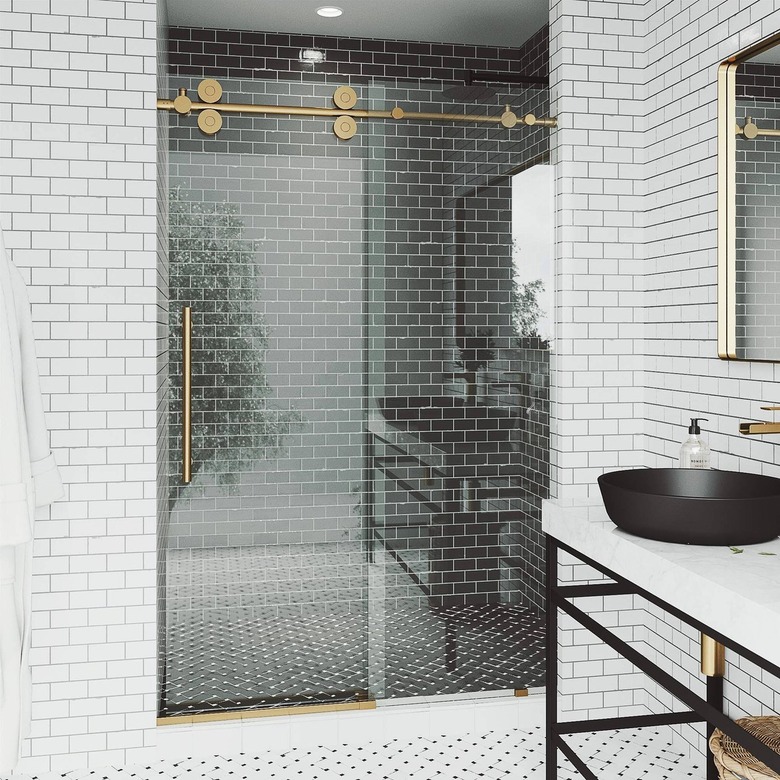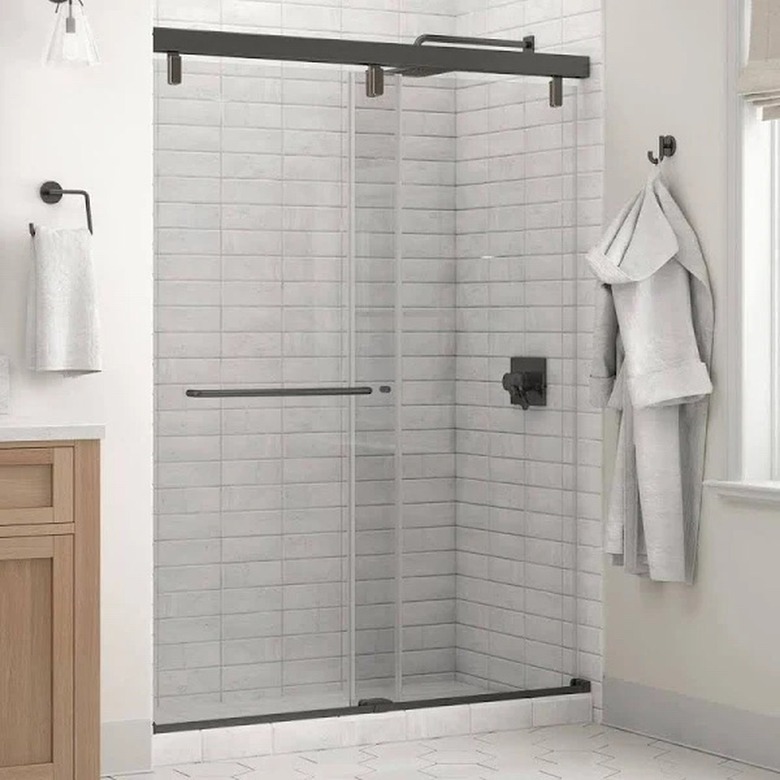Sliding Shower Doors: What You Need To Know
We may receive a commission on purchases made from links.
When it comes to style, inexpensive sliding shower doors are just a step above shower curtains, but if you have the budget for top-of-the-line models, the sky's the limit in terms of design punch — not that anything is wrong with an inexpensive sliding shower door, such as the Sterling Deluxe, which is utilitarian and so easy to install that you can do the job yourself. Pricier sliding shower doors add more class during a shower remodel, though, and they don't have many of the problems associated with basic ones, such as metal tracks that corrode and collect mold, but there's no problem you can't handle with regular maintenance.
Framed, Frameless and Semiframeless Doors
Framed, Frameless and Semiframeless Doors
When choosing a shower door, you have your choice between framed, semiframeless, and frameless, and you have the same options when shopping for sliding shower doors plus one more: A semiframeless sliding door, such as the DreamLine Encore, is one that mounts in a metal frame but has no frame itself. By contrast, a frameless sliding door, such as the Vigo Elan, has only an overhead track.
Frameless and semiframeless doors are typically constructed with 3/8-inch or thicker tempered glass as opposed to the 1/4-inch tempered glass used to make framed doors. The sturdy glass of a frameless door forms a seal against the side of the shower enclosure but not a perfect one, so leakage can be a problem with the frameless design, and that problem is solved by the U-channel that comes with a semiframeless model.
Sliding Shower Doors Are Bypass Doors
Sliding Shower Doors Are Bypass Doors
Every sliding shower door comes with two panels, and one may be fixed, or they both may slide. This arrangement means that the width of the shower opening must be about twice the width of one of the panels, which places a limit on the minimum width of the shower opening. The narrowest bypass shower door set fits in a 48-inch frame, which is too wide for a standard shower enclosure, for which a pivot shower door would be more suitable.
A typical standard width for bypass shower doors is 58 5/8 inches, which is suitable for a 5-foot alcove bathtub with a shower, and this is one of the most common applications of sliding shower doors. The standard height is 5 feet high, but you can find higher and wider shower doors for a better fit.
Benefits of Sliding Shower Doors
Benefits of Sliding Shower Doors
Sliding shower doors are space savers, which is especially important in small bathrooms. Since the doors slide along the tub's edge instead of swinging out into the bathroom, so you don't need extra space for the door to swing. It works well if the shower is near your toilet, for example, since a swinging shower door might hit the toilet.
Additional benefits of sliding shower doors include:
- A design upgrade: If you've been suffering with a shower curtain, an attractive sliding door gives your bathroom decor a big upgrade.
- Two entry options: Both sides of bypass doors often open, which means you can enter on either side. If you want to start the shower to warm it up, you can slide open the side near the faucet and use the other side to enter so you're not stepping directly into the spray.
- Versatile: Sliding doors work equally well on standard showers and tub-showers.
Besides these advantages, sliding shower doors provide a built-in handle that can serve as a towel rack, which is a boon for any space-starved bathroom. It's no substitute for a grab bar and shouldn't be used as such, but it's a handy repository for face cloths and small towels.
Cons of Sliding Shower Doors
Cons of Sliding Shower Doors
Framed and semiframeless sliding shower doors have an important drawback, and that's the frame. U-channel frames, especially the bottom track, collect soap residue and grime. When these contaminants mix with water from the shower, bacteria and mold can grow and create less-than-sanitary conditions in the bathroom. To prevent this, you have to clean the tracks frequently, which can be troublesome because they have deep crevices that are hard to clean.
If you purchase a sliding door with stainless steel tracks, you have another potential problem if you're used to cleaning the bathroom with a product that contains bleach. Bleach contains chlorine, and chlorine permanently stains stainless steel with microscopic pits. You should also avoid abrasives when cleaning stainless steel because they can erode the chromium wear layer and cause the metal underneath to rust.
The fact that sliding shower doors are bypass doors can both increase access to the shower or tub area and limit it. If both doors slide, you can open both of them to one side of the shower opening or the other, which gives you access to both sides of the enclosure. On the other hand, the width of the opening can never be more than that of one of the doors.
Design Options for Sliding Shower Doors
Design Options for Sliding Shower Doors
It's easy to find sliding shower doors with clear glass, especially frameless doors, and the clarity of the glass adds to the design elegance. If privacy in the shower is a priority, you can also find models with frosted glass, and as long as you install the door with the frosted side facing into the bathroom, it's no more difficult to keep clean than a clear glass door. Depending on the degree of privacy desired, Delta offers shower doors with Transition glass (which is frosted in the middle and clear on the top and bottom), Niebla glass (which is almost opaque), and exotic patterned glass.
In terms of design, the top track of the door as well as the frame (if there is one) is just as important as the glass. Aluminum, stainless steel, and chrome are basic options, but you can also find brushed nickel frames as well as white and matte-black enameled ones, which work well with stone or tile shower enclosures.
Sliding Glass Door Installation
Sliding Glass Door Installation
Shower door manufacturers usually recommend professional installation, not because the procedures are difficult but because the glass is fragile and can crack or shatter if mishandled. Nevertheless, you can make a DIY project out of installing your new sliding shower or bathtub door. The procedure varies depending on the type of door you're installing, so it's always important to read and understand the manufacturer's instructions.
Installation involves these steps:
- Measure the width of the shower opening and the length of the tub rim or the shower base from wall to wall.
- Cut the jamb tracks, the base track, and the header to fit, using a hacksaw. When installing a frameless door, you only have to worry about the header.
- Tape the tracks in place and mark the screw holes. Drill holes for all the tracks and components you need to install. If the enclosure is tile or stone, use a masonry bit and tap a conical anchor into each hole to hold the screw.
- Install the tracks using the hardware included. Place silicone caulk along the bottom of the bottom track before installing it. If the door set includes a fixed panel, install that according to the manufacturer's instructions.
- Hang the door from the header using the rollers provided with the set.
- Adjust the rollers to ensure smooth operation.
- Seal all the tracks on both sides with silicone caulk.
- Install the door handles.
Installing any type of glass sliding door in the bathroom is a two-person job, and you should always use suction handles when transporting the doors to maintain your grip and save your back. While it's preferable for the walls on either side of the tub or shower enclosure to be straight, most shower door kits include adjustable rollers that allow you to compensate for slightly out-of-plumb walls.
Care and Maintenance of Sliding Shower Doors
Care and Maintenance of Sliding Shower Doors
It's a mistake to think your glass shower doors don't need maintenance, and it won't take long for you to realize the error of your ways because they'll get streaked by hard water deposits, discolored by mold, and muddied by soap residue in no time. Fortunately, maintenance doesn't require much effort, but there are some things you should do and some things you should avoid doing.
At the top of the list of things to do to clean your shower door is to squeegee water droplets off the door every time you use the shower to remove hard water before it has a chance to evaporate and leave difficult-to-remove calcium deposits behind. Encourage others to do the same by hanging the squeegee in a prominent place inside the shower enclosure. You should also clean the glass periodically with a glass-specific cleaning solution and a microfiber cloth, and you might also consider treating it with a water repellant, such as Rain-X. If hard water streaks do develop, spray them with a 20 percent solution of vinegar and water to which you've added a squirt of dish soap.
Glass cleaner is the safest product to use for cleaning the door tracks and hardware because it won't dull metal finishes, but you can also use a solution of dish soap and water. Avoid using bleach or ammonia. Use the same mild soap solution to clean the rubber door seals to prevent them from caking up with gunk and apply petroleum jelly periodically to keep them pliable. Even with care, the seals may have to be replaced after several years of use, but they are easy to remove, and they are usually inexpensive.
References
- Insight Glass: Framed vs Semi Frameless vs Frameless Shower Enclosures
- Dimensions in Glass: 7 Reasons to Choose a Sliding Shower Door
- Shower Lagoon: Sliding Shower Door Vs. Hinged Shower Door: Which Is Right for You?
- The Maids: The Do's & Don'ts for Cleaning Stainless Steel
- Delta: Transparent vs. Opaque Shower Doors: Which Is Best?
- Glass Doctor: How to Install a Sliding Glass Shower Door
- Creative Mirror & Shower: Shower Door Care & Maintenance

